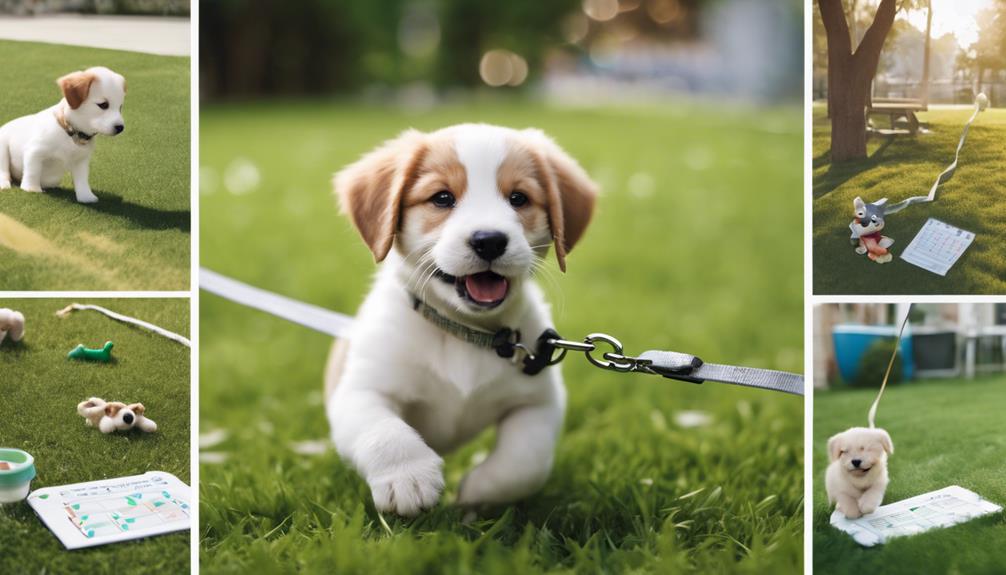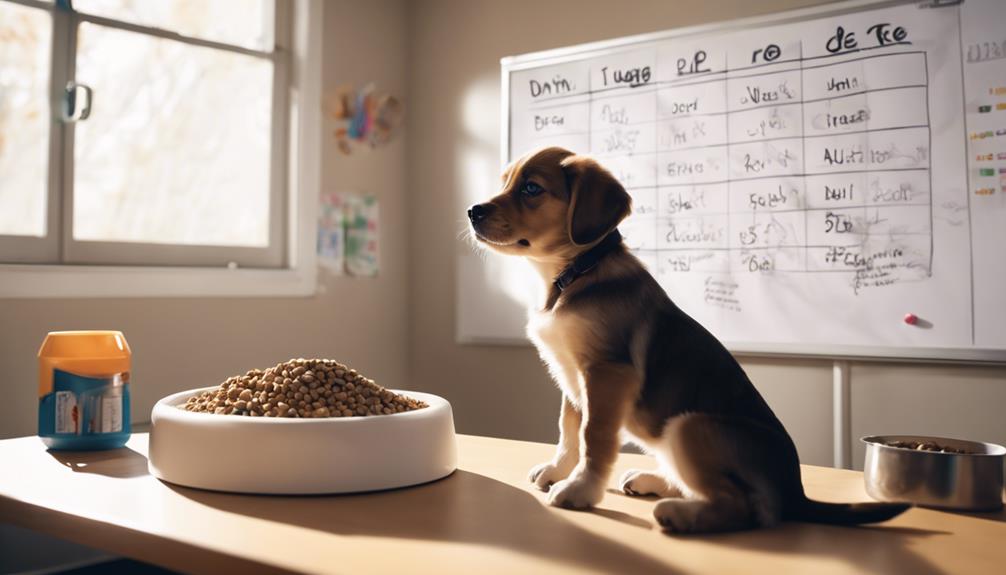Setting up the Perfect Puppy Feeding Schedules
- Advertisement -
It would help if you established a consistent puppy feeding schedule to guarantee your puppy’s sense of security and stability, regulate their digestive system, and prevent overeating or undereating. Typically, puppies require three to four meals per day, spaced evenly apart, with consideration for age, breed, and activity level. Feed at the same times every day, such as twice a day for puppies over six months, and use a feeding chart or app to track meals. Consult with a veterinarian to determine the best feeding schedule for your puppy, and by doing so, you’ll be well on your way to creating a well-structured routine that sets your puppy up for success.
Key Takeaways
- A consistent puppy feeding schedule provides security and stability, regulating their digestive system and preventing overeating or undereating.
- Puppies under six months typically need three to four meals per day, while older puppies can thrive on two meals, considering age, breed, and activity level.
- Establish a routine by feeding at the same times every day, such as twice a day for puppies over six months, and track meals using a feeding chart or app.
- Consult with a veterinarian to determine the best feeding schedule for puppies, taking into account factors like energy level, growth rate, and breed-specific needs.
- Divide the daily ration into designated meals, and introduce new dog food slowly to prevent digestive upset, following packaging guidelines or consulting a veterinarian.
Establishing a Puppy Routine
Establishing a Puppy Feeding Schedule for a Sense of Security and Stability
A consistent puppy feeding schedule is crucial for your new furry friend’s sense of security and stability.
Puppies need frequent meals, and a regular feeding routine helps them develop good eating habits and feel secure.
Typically, puppies require three to four meals per day, spaced evenly apart. Divide your puppy’s daily ration of puppy food into these meals and adjust as needed based on their growth and development.
Feed your puppy at the same times every day, so they can anticipate meal times. This helps regulate their digestive system and prevents overeating or undereating.
Using a feeding chart or app is an excellent way to track your puppy’s meals and stay on schedule. Consistency is key, so stick to your routine and make adjustments as your puppy grows.
A regular feeding schedule is vital for your puppy’s overall health and well-being, helping them develop healthy eating habits that will last a lifetime.
In addition to feeding, regular grooming is essential for maintaining your dog’s overall health and well-being.
Brush your puppy’s coat regularly to prevent matting and tangling.
Feeding and Hydration Essentials
Establishing a consistent feeding routine is crucial for your puppy’s health and well-being. Puppies need to eat three times a day, unlike mature dogs that eat once or twice a day.
Plan mealtimes around human breakfast, lunch, and dinner to make it easier to remember.
Feed puppy food according to your puppy’s age and breed, taking into account factors such as energy level and growth rate.
Consult with a veterinarian to determine the best feeding schedule for your puppy.
For puppies with food sensitivities, novel protein sources like duck or kangaroo can be beneficial.
Different breeds have varying energy levels and growth rates.
Small-breed puppies need more frequent meals to prevent hypoglycemia, while large-breed puppies need smaller meals to prevent bloat.
Feed puppies 3-4 times a day until they’re six months old, then gradually shift to twice a day.
Consider factors like spaying or neutering, which may reduce calorie needs.
Hydration is equally important.
Ensure your puppy always has access to fresh, clean water.
Wash out the water bowl regularly and refill it as needed.
Puppies need constant access to water to stay hydrated and healthy.
Potty Breaks, Exercise, and Play

Establish a routine for taking your puppy outside to prevent accidents and maintain a consistent potty training schedule.
Take your puppy out at least every two to four hours, as well as after meals and playtime, when they’ll need to relieve themselves immediately.
Puppies tire easily and need regular breaks to avoid fatigue and stress. Their immune systems aren’t yet fully developed, so it’s vital to monitor their health closely.
Regular breaks help your puppy learn when it’s time to go and reduce the risk of accidents in the house.
This schedule also allows you to observe your puppy’s behavior and adjust the routine as needed.
Outdoor Break Reminders
Establishing a consistent outdoor break routine is crucial for puppies during their first few months.
This routine should include potty breaks, exercise, and play. Create a schedule that ensures your puppy gets enough outdoor time to thrive. Puppies grow rapidly, have high energy levels, and require frequent potty breaks.
Feeding your puppy at scheduled meals helps regulate their bathroom habits, making it easier to anticipate when they’ll need an outdoor break.
Be prepared to adjust your schedule as needed, as every puppy is different.
Regular coat brushing can reduce shedding and prevent matting, which is especially important during this stage.
Set reminders to take your puppy outside after meals, naps, and playtime to ensure they get enough opportunities to relieve themselves.
Incorporating outdoor breaks into your puppy’s routine helps develop good habits and reduces the likelihood of accidents in the house.
A well-planned meal schedule and outdoor break reminders provide the care your puppy needs to grow into a healthy, happy dog.
Schedule Regular Breaks
Establish a routine for regular breaks to support your puppy’s development.
Factor potty breaks, exercise, and playtime into your feeding schedule. Take your puppy outside every two-to-four hours and after each activity change to minimize accidents during house training.
Puppies need to relieve themselves immediately after meals and playtime, so schedule potty breaks accordingly.
Keep an eye on your puppy at all times to prevent accidents and ensure they get enough exercise and interaction.
Regular veterinary check-ups are crucial for detecting health problems like parvovirus and distemper early on. A balanced diet is essential for the growth and development of the skeleton, skin, and coat.
Short play sessions throughout the day can help expand your puppy’s energy and prevent destructive behavior.
Different breeds have different energy levels and growth rates, so adjust the frequency and duration of potty breaks, exercise, and playtime accordingly.
Schedule breaks between meals to support your puppy’s growth.
Immediate Relief Needed
Immediate Relief Needed for Puppies
Puppies have small bladders and can’t hold their urine for long periods.
Taking them outside frequently, especially after meals and playtime, is crucial to prevent accidents.
A balanced diet is essential for a puppy’s growth and development.
Overfeeding or underfeeding can lead to health issues, including poor growth and a weak immune system.
To minimize accidents during house training, take your puppy outside at least every two to four hours and after every change of activity.
This ensures they’ve enough opportunities to relieve themselves.
Short play sessions throughout the day can help puppies expend energy and reduce the likelihood of accidents.
As your puppy grows, adjust the potty break and exercise schedules to meet their individual needs.
Different breeds have different energy levels and growth rates, so be prepared to make changes over the next few months.
For example, you may need to adjust the feeding schedule as they grow.
Keep a close eye on your puppy at all times to prevent accidents and guarantee they’re getting enough opportunities to relieve themselves.
Sleep, Rest, and Relaxation Needs
When creating a puppy feeding schedule, remember that your puppy’s sleep, rest, and relaxation needs are equally important.
Puppies require a balanced diet rich in energy and minerals, such as calcium, phosphorus, and zinc, to support their growth and development.
To ensure they get enough rest, prioritize quiet time management and establish a consistent nap time routine. Puppies sleep for 16-18 hours a day and need undisturbed rest to recharge.
Puppy Sleep Patterns
Puppies need a lot of sleep – 16-18 hours a day.
A consistent sleep schedule is crucial for their growth and development. This includes quiet nap times to help them recharge.
To ensure your puppy gets enough rest, family members should learn not to disturb them during naps. Crate training can be helpful in this regard, as it prevents distractions and allows puppies to sleep undisturbed.
Establishing a routine is vital for successful potty training.
A set bedtime helps develop good potty habits by allowing you to monitor your dog’s behavior and identify signs they need to go.
- Advertisement -
Aim for 18-20 hours of sleep per day, including naps.
Provide a quiet, comfortable space for sleeping, away from high-traffic areas, to help your puppy get a good night’s sleep.
Consistency is key to developing a routine.
Quiet Time Management
Managing Quiet Time for Your Puppy
Puppies need daily quiet time to recharge, and it’s crucial to manage it effectively.
Since they sleep a lot (up to 16-18 hours a day), they require uninterrupted quiet nap times.
As part of their feeding schedule, quiet time management is essential to prevent hypoglycemia and ensure they get the rest they need.
Puppies need regular breaks and rest periods to avoid exhaustion from excessive physical activity.
A tired puppy is a well-rested puppy.
Family members should learn not to disturb the puppy during naps.
Crate training can help them get the quiet time they need.
Establish a bedtime routine, such as a relaxing walk or massage, to signal to the puppy that it’s time to sleep.
A set bedtime is vital for developing a routine, making house training easier, and guaranteeing your puppy gets 18-20 hours of sleep per day, including naps.
By incorporating quiet time management into your puppy’s feeding schedule, you’ll provide a healthy and well-balanced routine.
This will help your puppy thrive and make your life easier as a pet owner.
Nap Time Routine
Establishing a consistent nap time routine is crucial for your puppy’s overall development. Puppies need 16-18 hours of sleep daily, so creating a quiet and distraction-free environment is essential.
Family members must learn not to disturb the puppy during naps to help them feel secure and develop good sleep habits.
Crate training is an effective tool for nap time, as it prevents distractions and aids in puppy development.
A balanced diet rich in energy and minerals, particularly calcium, phosphorus, and zinc, is also vital for growth and development.
Regular veterinary check-ups are necessary for detecting health problems early, which can impact sleep and overall well-being.
To establish a nap time routine, set a regular schedule and bedtime routine to signal to your puppy that it’s time to sleep.
A relaxing walk or massage can help them adjust to a regular sleep schedule.
Aim for 18-20 hours of sleep per day, including naps, to ensure your puppy gets the rest they need.
A set bedtime will also make house training easier and help your puppy develop a routine.
Incorporating a nap time routine into your puppy’s feeding schedule guarantees they get the sleep they need to thrive.
Setting Boundaries and Managing Challenges

Establishing a feeding routine is crucial when it comes to caring for your puppy. A set schedule helps prevent hypoglycemia, a common issue in puppies, and ensures they receive the necessary nutrients.
To create an effective feeding schedule, consider your puppy’s age, breed, and activity level.
This will help you determine the ideal frequency and amount of food. For example, puppies need to eat more frequently than adult dogs and high-energy breeds require more food than low-energy breeds.
Tailored nutrition is also essential.
Novel protein sources and limited-ingredient diets can make a significant difference in a dog’s health and well-being. However, it’s crucial to choose a diet that meets your puppy’s specific needs.
Meal toppers can be a helpful addition to your puppy’s meals, providing extra nutrients and flavor.
However, it’s essential to choose a topper that complements their regular food and doesn’t disrupt their digestive system.
Remember, every puppy is unique, and what works for one may not work for another.
Creating a Feeding Schedule by Age
Creating a Feeding Schedule by Age
Puppies have different energy needs at various stages of their life. Up to three months old, feed your puppy every 3-4 hours, as they’ve small stomachs and high energy needs.
Provide puppy food four to six times a day. Select high-quality, low-calorie training treats, such as limited-ingredient treats, to support growth without causing weight gain. Consider the breed and size of your puppy when creating a feeding schedule, as they may have different needs.
From three to six months old, switch to three meals a day, every 5-6 hours, as their stomachs grow and energy needs decrease.
Between six to twelve months old, gradually switch to two meals a day, every 8-12 hours, as they approach physical maturity.
However, consider the breed and size of your puppy when creating a feeding schedule. Toy and small breed puppies need three to four meals a day until they’re six months old.
Medium-breed puppies need three meals a day until six months old. Large breed puppies and giant breed puppies should be fed two to three times a day until they’re six months old to prevent overfeeding and promote healthy growth.
Benefits of Scheduled Feeding Times

Scheduled feeding times provide a sense of routine and predictability for your puppy, promoting feelings of security and good eating habits.
This structure helps your puppy understand when it’s time to eat, reducing anxiety and stress related to mealtime. By establishing a routine, you can monitor your puppy’s appetite and adjust the feeding schedule as needed. A consistent feeding schedule is also essential for managing food sensitivities, which is crucial for your puppy’s health.
Scheduled feeding times offer several benefits:
- Feeding your puppy at specific times helps regulate their digestive system, reducing the risk of gastrointestinal issues.
- Controlling the amount of puppy food your puppy consumes prevents overeating and maintains a healthy weight.
- When your puppy knows exactly when they’ll receive their next meal, they’re less likely to beg for food throughout the day.
Free feeding, where food is available at all times, can lead to overeating and obesity.
In contrast, scheduled feeding times ensure your puppy receives the nutrients they need to thrive. This approach allows you to provide your puppy with the best feeding experience possible, whether that’s twice per day or smaller meals throughout the day. A consistent feeding schedule is vital for supporting your puppy’s overall health and well-being.
Remember, establishing a routine is key to providing your puppy with a healthy and balanced diet.
Tips for Setting Feeding Times Successfully
When setting a feeding schedule for your puppy, consider their age, breed, and activity level.
Puppies under six months typically need three to four meals per day, while older puppies can thrive on two meals. Larger breeds may require more food, while smaller breeds need less.
Introduce new dog food slowly to prevent digestive upset, following packaging guidelines or consulting a veterinarian.
Establish a routine by feeding your puppy at the same times every day, such as twice a day for puppies over six months. This consistency helps regulate their digestive system and prevents overeating or undereating.
Active puppies may require more frequent meals to maintain energy levels.
Choose a high-quality puppy food that meets their nutritional needs, and divide their daily ration into the designated number of meals.
Monitor your puppy’s weight and adjust their food intake accordingly to prevent overfeeding or underfeeding.
A well-planned feeding schedule supports your puppy’s growth and development.
Frequently Asked Questions
What Is a Good Puppy Feeding Schedule?
To create a good puppy feeding schedule, consider your puppy’s age and adjust the frequency, portion size, and nutrient intake accordingly. Monitor hunger cues, eating habits, and weight to ensure they receive the right amount of water and nutrients at the right times.
What Is an Ideal Puppy Schedule?
A daily puppy routine should balance socialization, breed-specific needs, and feeding frequency. This routine should consider meal portion control, puppy growth rate, and health monitoring while fitting into your lifestyle.
What Is the Feeding Pattern for Puppies?
Establish a consistent feeding routine for your puppy based on their age, breed, and size to ensure proper nutrition. As a general rule, feed 1-1.5 cups of food per 10 pounds of body weight daily, divided into 3-4 meals. Monitor your puppy’s weight and adjust feeding times and amounts as they grow.
What Are the Complete Puppy Feeding Guidelines?
Mastering puppy nutrition basics is crucial for a healthy pup. To get it right, follow these guidelines:
Understand feeding frequency rules, use meal portion guides, and adopt age-based feeding and breed-specific diets. Consult with your veterinarian for personalized recommendations and ignore common puppy feeding myths.
In summary
Establishing a puppy feeding schedule is crucial for a healthy, happy pup. A consistent routine helps meet your puppy’s unique needs. To create an effective schedule, follow these guidelines and make adjustments as needed. Consistency is key, so stick to your schedule. With time and patience, your puppy will thrive.
- Advertisement -

